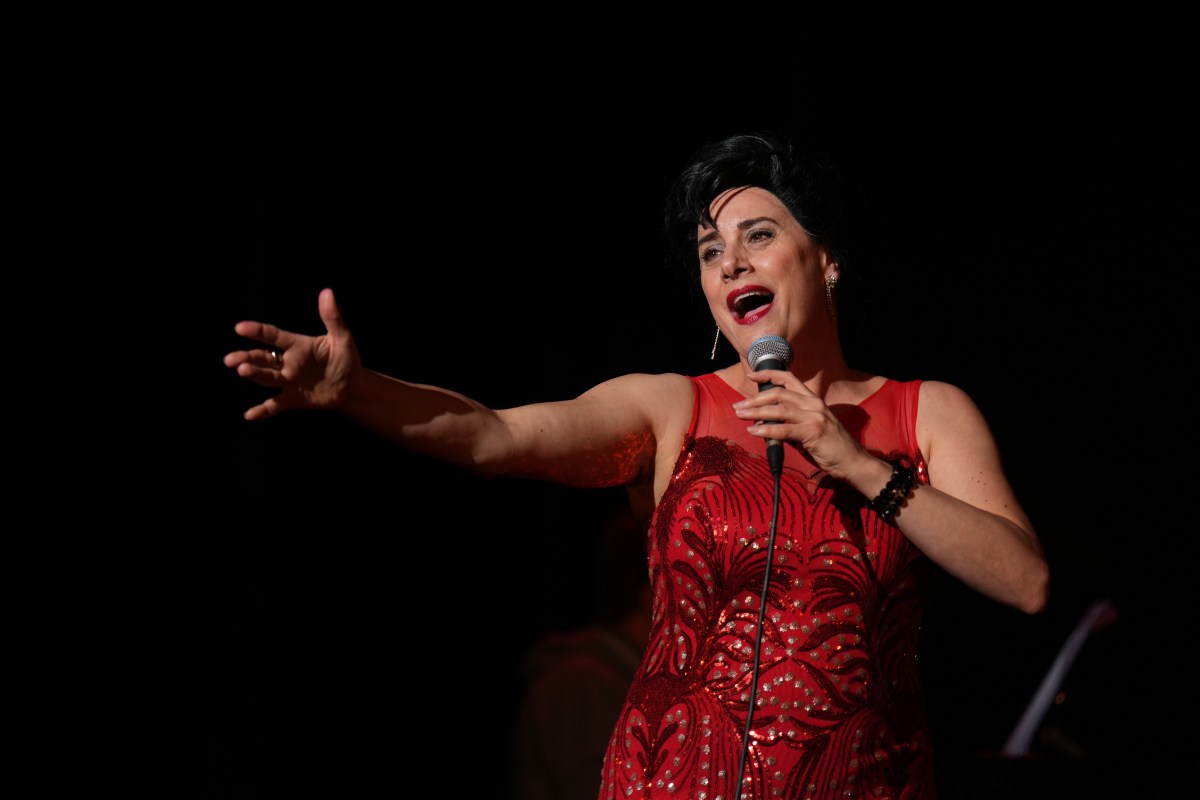Let’s be clear: this show was a star vehicle for singer Nina Ferro – and she, in essence, was the show. In JUDY • AUSTRALIA • 1964, she became – beautifully, perfectly, heartbreakingly – Judy Garland.
Born in 1922 as Frances Ethel Gumm, Judy Garland was an infamously tragic figure. A child star in the time when the major film studios essentially contractually owned their stars, she was signed to Metro-Goldwyn-Mayer (one of the world’s largest film studios at the time) in her early teens. Garland appeared in 28 films from 1935 until the negotiated release from her contract in 1950 (following her firing from the set of Annie Get Your Gun, the break-up of her marriage to Vincente Minnelli and publicised suicide attempts), including the film that made her a household name, The Wizard of Oz (1939) – made when she was just 17.
From her teen years, she was given (as were many stars of the time) ‘pep’ pills (amphetamines) to ensure she could keep up with the studio’s gruelling rehearsal and performance schedule, and then sedatives to put her to sleep. The lifestyle led to Garland developing alcohol and substance abuse issues that plagued her until her death, by what was determined an accidental barbiturate overdose, in 1969.
In JUDY • AUSTRALIA • 1964, we followed the story of Garland throughout her three-concert tour of Australia – as she performed in Sydney twice, to great acclaim, before coming to Melbourne, where things degenerated.
Helpmann Award-winning actor and singer Matt Hetherington played Harry M Miller – the New Zealand-born entrepreneur who brought Garland to Australia in 1964, as well as many other famous international acts from the time, including The Beach Boys, Louis Armstrong, Ella Fitzgerald and The Rolling Stones. He spoke directly to the audience – filling the gaps between Ferro’s songs, contextualising the events of the tour with appropriately salesman-like charismatic charm.
The story, written by Bill Farr, neatly captures the drama inherent in Garland’s tragic personal life – the high highs of a brilliant, seasoned performer, chased down by her own demons and, finally, dying a death-on-stage at the hands of her audience (she showed up 70 minutes late to her Festival Hall show in Melbourne and her performance was a disaster). ‘I gave you everything,’ Ferro, as Garland, said to us, her current day Melbourne audience standing in for her 1964 audience, ‘but what did you ever give me?’
Ferro was nothing short of brilliant.
Her voice was so powerful – an instrument of technical and emotional mastery. Hetherington as Miller talked about how it was Garland’s ‘phrasing’ that made her voice so special – and that was certainly part of the magic in Ferro’s performance: that ability to create a mood, express a feeling, in the singing of a musical phrase, which requires not just technical brilliance, but a deep and powerful connection to the nuanced meaning of the words – so that in the intake of breath, the hung pause, the slight crack or the powerful belt, we as an audience felt our own breath catch, our soul soar and our heart break with her.
The first act of the show was suitably peppered with more upbeat numbers – ‘The Trolley Song’, ‘Swanee’, ‘When You’re Smiling’ – before the events of the second act led us into more melancholic numbers, including ‘The Man That Got Away’, ‘If I Love Again’ and ‘As Long as He Needs Me’.
Towards the end, Ferro’s rendition of ‘Somewhere Over the Rainbow’, foreshadowed by the stage band’s opening overture, was more stripped back. As Garland, she stumbled to the stool that Miller handed her, barely able to hold herself together anymore. She sat facing us, and in that opening interval ‘Some-where’ we hear all her pain and joy and sorrow expressed – it contained at once the promise of hope and the reality of its inevitable destruction. Supported only by musical arranger and pianist Steve Semmler-Farr on piano, Ferro’s voice let us hear the life of Garland: its glorious successes and abject failures. It was a playful, sorrowful and moving performance.
Full disclosure – I was crying during the very first song, and a number of times throughout the show, until the rousing standing ovation Ferro received in St Kilda’s National Theatre. She was just so good, so out-of-this-world good.
Ferro captured the essence of Garland’s tragic persona, we heard the vocal characteristics that made Garland’s voice so distinctive – the vibrato, her slight huskiness and back-of-throat Transatlantic Golden-Age-of-film accent that comes through in her singing – but this was no simple imitation. Ferro has absorbed these qualities – and her performance of Garland was embodied and true, her own.
The role the supporting stage band played should not to be undervalued. The veins of rhythmic and phrasal connection between Ferro and the seven-piece band, conducted by Philippa Edwards, coursed with life – it’s what made the performance so vital and in the moment.
Read: Dance review: IN Cognito, Ballet at the Quarry
As it was performed across only two nights as part of Midsumma Festival this year in St Kilda’s National Theatre – a historic beaux-art proscenium arch theatre, built in 1921 – I only hope that this show can come back again, so more people can see it. It’s begging for a bigger production budget and marketing spend to have it in one of our larger theatres, for a longer run.
Far more people deserve to experience Ferro’s outstanding performance in JUDY • AUSTRALIA • 1964 – if not, that would be the real tragedy.
JUDY • AUSTRALIA • 1964
National Theatre, St Kilda, Melbourne
Writer: Bill Farr
Director: Lauren McKinnon
Musical Director: Phillipa Edwards
Musical Arrangements: Steve Semmler-Farr
Cast: Nina Ferro, Matt Hetherington
The band: Steve Semmler-Farr, Geoff Morris, Anthony Pell, Jordan Kiely, Martin Hemingway, Jamie Lawson, Daniel McIlvride
JUDY • AUSTRALIA • 1964 was performed on 10-11 February 2023, as part of Midsumma Festival.





